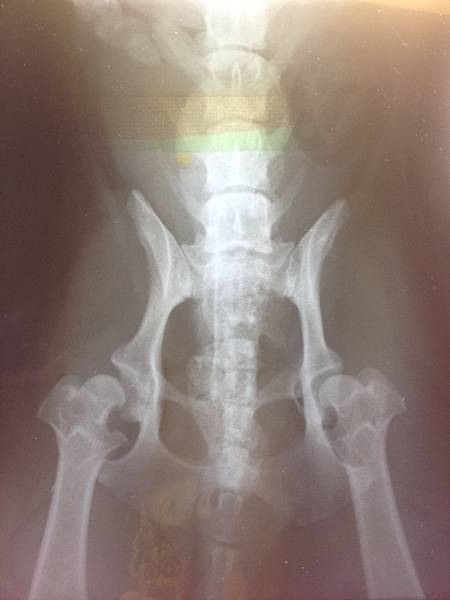OFA(美國動物骨科協會)對CHD的介紹
譯者:泡泡拔
資料來源:http://www.offa.org/hd_info.html
The Dysplastic Joint(發育不全的關節)

柯基犬嚴重CHD的X光範例
Hip Dysplasia is a terrible genetic disease because of the various degrees of arthritis (also called degenerative joint disease, arthrosis, osteoarthrosis) it can eventually produce, leading to pain and debilitation.
髖關節發育不全是一種嚴重的遺傳疾病,伴隨著於不同程度的關節炎(也可以被稱為退化性關節疾病),最終可能會引起犬隻的疼痛與衰弱。
The very first step in the development of arthritis is articular cartilage (the type of cartilage lining the joint) damage due to the inherited bad biomechanics of an abnormally developed hip joint.Traumatic articular fracture through the joint surface is another way cartilage is damaged. With cartilage damage, lots of degradative enzymes are released into the joint. These enzymes degrade and decrease the synthesis of important constituent molecules that form hyaline cartilage called proteoglycans.This causes the cartilage to lose its thickness and elasticity, which are important in absorbing mechanical loads placed across the joint during movement. Eventually, more debris and enzymes spill into the joint fluid and destroy molecules called glycosaminoglycan and hyaluronate which are important precursors that form the cartilage proteoglycans. The joint's lubrication and ability to block inflammatory cells are lost and the debris-tainted joint fluid loses its ability to properly nourish the cartilage through impairment of nutrient-waste exchange across the joint cartilage cells. The damage then spreads to the synovial membrane lining the joint capsule and more degradative enzymes and inflammatory cells stream into the joint. Full thickness loss of cartilage allows the synovial fluid to contact nerve endings in the subchondral bone, resulting in pain.In an attempt to stabilize the joint to decrease the pain, the animal's body produces new bone at the edges of the joint surface, joint capsule, ligament and muscle attachments (bone spurs). The joint capsule also eventually thickens and the joint's range of motion decreases.
“退化性關節炎”開始發展的第一步,是起因於異常髖關節所遺傳到的不良生物力學機制(不好的運動結構),進而造成關節軟骨(articular cartilage:內襯於關節內的一種軟骨) 的傷害。外力所造成的關節表面損傷性破裂,也可能是造成軟骨受損的原因之一。
關節軟骨受到損傷之後,隨之而來的,將會是有許多”分解性酵素”被釋放到關節中。這些”分解性酵素”分解並降低了軟骨素的合成 (proteoglycans:形成透明軟骨的重要組成分子)。這使得軟骨失去了厚度與延展性,厚度與延展性對於幫助關節吸收運動時所產生的機械性承載,是相當重要的。
最後,許多湧進關節液中的碎片與分解酵素,破壞了氨基葡聚糖(glycosaminoglycan, GAG)與玻尿酸 --- 形成軟骨素的兩個重要前趨物。關節於是喪失了潤滑與抑制發炎細胞的能力,而充滿了碎片的關節液也無法適當地滋養軟骨,因為關節軟骨細胞之間失去了進行”養份-廢物交換作用”的能力。緊接著傷害擴散到關節囊中的”滑液膜”,於是更多的分解酵素和發炎細胞湧入了關節之中。軟骨的厚度消磨殆盡,使得滑液得以與軟骨下方硬骨的神經末稍接觸,就此導致了疼痛。
為了試圖穩定關節並減輕疼痛,動物的身體在關節表面的邊緣製造了新的骨頭、關節囊、韌帶還有肌肉連結(也就是骨刺)。關節囊不停的增厚,所以關節的活動角度也持續的減小。
No one can predict when or even if a dysplastic dog will start showing clinical signs of lameness due to pain. There are multiple environmental factors such as caloric intake, level of exercise, and weather that can affect the severity of clinical signs and phenotypic expression (radiographic changes). There is no rhyme or reason to the severity of radiographic changes correlated with the clinical findings. There are a number of dysplastic dogs with severe arthritis that run, jump, and play as if nothing is wrong and some dogs with barely any arthritic radiographic changes that are severely lame.
即便是確定有發育障礙的犬隻,依然沒有人可以預測狗狗何時會出現因疼痛而跛行的臨床症狀。有許多環境因子,如卡路里的攝取、運動的程度和天氣,都有可能影響臨床症狀的嚴重程度和關節型態的呈現(就是X光片上看到的變化)。不會有一定的理由或規律,可以將X光檢查的嚴重程度和實際的臨床表現連結在一起。有些患有嚴重退化性關節炎的狗兒,可以彷彿沒有任何問題的跑、跳和嬉戲,但也有些狗兒在X光片上看來只有極輕微的關節炎變化,卻出現嚴重跛腳的情形。
小編備註:
美國動物骨科協會,簡稱OFA,全世界最有公信力的健康疾病篩的非營利組織,設立於1966年,源起於協助繁殖者來追蹤髖關節發育不全症,近年來,OFA增加資料庫來協助繁殖者追蹤肘關節、膝蓋 骨畸形、先天性心臟病…等更多遺傳疾病及DNA資料庫。
OFA的任務是
一、整理並傳播關於動物外科及基因疾病的資訊
二、建議、鼓勵及建立控制計畫來降低外科及基因疾病
三、鼓勵並以財務支援動物外科及基因疾病的研究
四、募款來實現組織的任務
依據OFA的判斷CHD的作法是是兩歲以前只做 評估,滿兩歲才做正式判定。由於CHD是發展性的疾病,兩歲時如果沒有 見到髖關節發育不全的症狀,才能判斷為無CHD,才可以作為繁殖用。在國外,患有CHD的犬隻是禁止繁殖的,除了同胎仔犬禁止繁殖,也會追溯至父母犬乃至 上幾代相關的直系旁系犬隻一併停止繁殖,但是無CHD的狗如有75%的兄弟姊妹有CHD也不建議作繁殖用,該組織也將經該組織已判定合格的犬隻建立資料庫 以供查詢。



 留言列表
留言列表

